|
|
 |
|
Cyclopoida ( Order ) |
|
|
|
Corycaeidae ( Family ) |
|
|
|
Corycaeus ( Genus ) |
|
|
|
Onychocorycaeus ( Sub-Genus ) |
|
|
| |
Corycaeus (Onychocorycaeus) agilis Dana, 1849 (F,M) | |
| | | | | | | Syn.: | Corycäeus gracilicaudatus Giesbrecht, 1892 (p.660, 674, figs.F);
Corycaeus gracilicaudatus : Thompson & Scott, 1903 (p.240, 286); A. Scott, 1909 (p.249, Rem.); Wolfenden, 1911 (p.360); Farran, 1911 a (p.290); Pesta, 1912 a (p.58, fig.F); 1913 (p.34); Sewell, 1948 (p.357); Maiphae & Sa-ardrit, 2011 (p.641, Table 2, 3, Rem.);
Onychocorycaeus agilis : Dessier, 1983 (p.89, Tableau 1, Rem., %); 1988 (tabl.1); Boxshall & Halsey, 2004 (p.494); McKinnon & al., 2008 (p.844: Tab.I, p.848: Tab. IV); Lan Y.-C. & al., 2009 (p.1, Table 2, % vs hydrogaphic conditions); Vives & Shmeleva, 2010 (p.232, figs.F,M, Rem.)
Corycaeus agilis : Smith & Madhupratap, 2005 (p.214, tab.4, 5) | | | | Ref.: | | | F. Dahl, 1894 (p.72); M. Dahl, 1912 (p.84, figs.F,M); Früchtl, 1924 b (p.95); Klevenhusen, 1933 a (p.88, chart 38); Farran, 1936 a (p.138); Mori, 1937 (1964) (p.134, figs.F); Dakin & Colefax, 1940 (p.113, figs.F); Sewell, 1947 (p.284, Rem.); Tanaka, 1957 (p.94, figs.F,M); 1960 (p.83, figs.M, Rem.); Fagetti, 1962 (p.51); Motoda, 1963 (p.238, figs.F); Cervigon, 1964 (p.187, figs.M); Tanaka, 1964 (p.15); Chen & al., 1974 (p.62, figs.F); Zheng & al., 1982 (p.147, figs.F); Kang & al., 1990 (p.53, figs.F); Chihara & Murano, 1997 (p.965, Pl.216,217: F,M); Boxshall, 1998 (p.224); Bradford-Grieve & al., 1999 (p.888, 975, figs.F,M); Al-Yamani & Prusova, 2003 (p.141, figs.F); Conway & al., 2003 (p.255, figs.F,M, Rem.); Al-Yamani & al., 2011 (p.117, figs.F) | 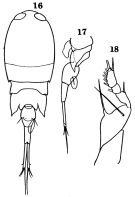 issued from : O. Tanaka in J. Fac. Agricult. Kyushu Univ., 1957, 11 (1). [Pl.8, Figs.16-18]. Female (from Japanese waters): 16, habitus (dorsal); 17, urosome (lateralleft side); 18, P4. Nota: The abdominal segments and furca in the proportional lengths 35:28:36.
|
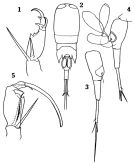 issued from : O. Tanaka in J. Fac. Agricult. Kyushu Univ., 1957, 11 (1). [Pl.9, Figs.1-5]. Female (from Japanese waters): 1, A2. Male: 2, habitus (dorsal); 3, urosome (lateral left side); 4, urosome (lateral right side), other specimen with spermatophores; 5, A2. Nota: The abdominal segments and furca in the proportional lengths 40:27:33. Some specimens with aminute median hooh on the ventral proximal corner of genital segment.
|
 &issued from : Q.-c Chen & S.-z. Zhang C.-s. Zhu in Studia Marina Sinica, 1974, 9. [Pl.20, Figs.10-13]. Female (from China Seas): 10, prosome (dorsal); 11, urosome (dorsal); 12, A2; 13, P4.
|
 Issued from : W. Giesbrecht in Systematik und Faunistik der Pelagischen Copepoden des Golfes von Neapel und der angrenzenden Meeres-Abschnitte. – Fauna Flora Golf. Neapel, 1892. Atlas von 54 Tafeln. [Taf.51, Fig.15]. As Corycäus gracilicaudatus. Female: 15, habitus (dorsal).
|
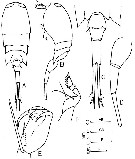 issued from : F.Y. Al-Yamani & I. Prusova in Common Copepods Northwestern Arabian Gulf : Identification Guide. Kuwait Institute for Scientific Research, 2003. [p.140, Fig.54]. Female: A, habitus (dorsal); B, idem (lateral left side); C, urosome (dorsal); D, idem (lateral left side); E, A2; F, P4. Nota: Proportional lengths of urosomites and caudal rami 34:29:39. A2 with marginal spine of basipod 1: 2.4 times longer than that of basipod 2.
|
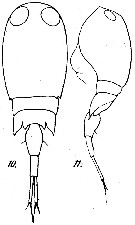 issued from : M. Dahl in Ergebnisse der Plankton-Expedition der Humboldt-Stiftung. Bd II, G. f1. I. Die Corycaeinen 1912. [Taf.XII, Figs.10, 11]. Female: 10, habitus (dorsal); 11, idem (lateral left side).
|
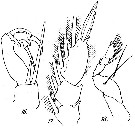 issued from : M. Dahl in Ergebnisse der Plankton-Expedition der Humboldt-Stiftung. Bd II, G. f1. I. Die Corycaeinen 1912. [Taf.XII, Figs.16, 17, 18]. Female: 16, A2; 17, endopod of P2; 18, P4.
|
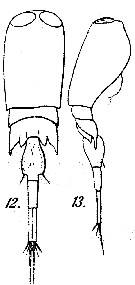 issued from : M. Dahl in Ergebnisse der Plankton-Expedition der Humboldt-Stiftung. Bd II, G. f1. I. Die Corycaeinen 1912. [Taf.XII, Figs.12, 13]. Male: 12, habitus (dorsal); 13, idem (lateral right side).
|
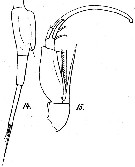 issued from : M. Dahl in Ergebnisse der Plankton-Expedition der Humboldt-Stiftung. Bd II, G. f1. I. Die Corycaeinen 1912. [Taf.XII, Figs.14, 15]. Male: 14, urosome (lateral right side); 15, A2.
|
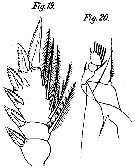 issued from : M. Dahl in Ergebnisse der Plankton-Expedition der Humboldt-Stiftung. Bd II, G. f1. I. Die Corycaeinen 1912. [Taf.XII, Figs.19, 20]. Male: 19, exopod of P1; 20, P4.
|
 issued from : G.P. Farran in Proc. zool. Soc. Lond., 1911. [Plate XI, Figs.11-12]. As Corycaeus gracilicaudatus. Male (from Christmas Island, Indian): 11-12, habitus (lateral and dorsal, respectively).
|
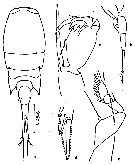 issued from : Z. Zheng, S. Li, S.J. Li & B. Chen inMarine planktonic copepods in Chinese waters. Shanghai Sc. Techn. Press, 1982 [p.148, Fig.93]. Female: a, habitus (dorsal); b, urosome (lateral, right side); c, A2; d, terminal spines of exopod of P2. Scale bar in mm.
|
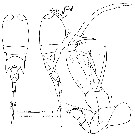 issued from : F. Cervigon iin Mem. Soc. Cienc. nat. La Salle, 1964, 24 (68). [p.188, Lam.17]. As Onyichocorycaeus agilis. Male (from Venezuela): 1-2, habitus (dorsal and lateral, respectively); 3, A2; 4, P4. Nota: Lengths ratio genital , anal segments and caudal rami 42:26:32 and 46:26:28.
|
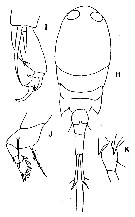 issued from : Y.S. Kang, S.-H. Huh & S.S. Lee in J. Ocanol. Soc. Korea, 1990, 25 (2). [Pl. 3, Figs.H-K]. Female (from Korean waters): H, habitus (dorsal); I, A2; J, P4; K, genital segment (lateral, right side). Nota: Lateral points of 3rd thoracic segment extended to 1/4 the genital segment. Urosome 1.4 times as long as cephalothorax.
|
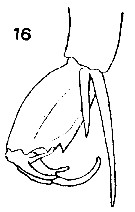 issued from : T. Mori in The Pelagic copepoda from the neighbouring waters of Japan, 1937 (1964). [Pl. 72, Fig.16]. Female: 16, A2.
|
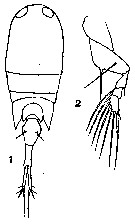 issued from : T. Mori in The Pelagic copepoda from the neighbouring waters of Japan, 1937 (1964). [Pl. 73, Figs.1-2]. Female: 1, habitus (dorsal); 2, P4.
|
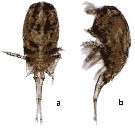 issued from : Y. Al-Yamani, V. Skryabin, A. Gubanova, S. khvorov & I. Prusova in Marine Zooplankton Practical Guide for the Northwestern Arabian Gulf, 2, 2011. [p.117, Fig.266]. Female (from Kuwait): a-b, habitus (dorsal and left lateral, respectively).
|
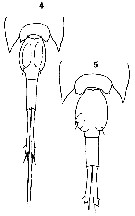 Issued from : O. Tanaka in Spec. Publs. Seto mar. biol. Lab., 10, 1960 [Pl. XXXVI, 4-5]. Male (from Indian Ocean): 4, abdomen (dorsal; specimen with long abdomen); 5, abdomen (dorsal; specimen with normal abdomen). Nota : Cephalothorax and abdomen in the proportional lengths 60 to 40. Abdominal segments and caudal rami in the proportional lengths 39 : 28 : 33 = 100. Genital segment about 1.6 times as long as broad (15 : 16); cylindrical part about 3/7 the length of the posterior border of the segment. Anal segment with nearly paralell lateral margins, 2.5 times as long as it is broad at the anterior border. Caudal rami 10 times as long as broad, slightly asymmetrical, the right ramus longer than the left. Remaks: Male specimens taken off the Cape of Good Hope are larger in size (0.84-0.90 mm) than those from the other Indian stations (0.70-0.79 mm). A male specimen measuring 0.76 mm had a long caudal rami (fig.4). The segments and caudal rami have the proportional length 36 : 25 : 39 = 100. The genital segment had a trace of the ventral hook. Characters female: Cephalothorax and abdomen in the proportional lengths 60 to 40;The abdominal segments and caudal rami in the proportional lengths 32 : 29 : 39 = 100.
| | | | | Compl. Ref.: | | | Wilson, 1942 a (p.179); 1950 (p.192); Chiba & al., 1957 (p.312); De Decker, 1964 (p.15, 21, 29, 32); De Decker & Mombeck, 1964 (p.12); Furuhashi, 1966 a (p.295, vertical distribution in Kuroshio region, Table 9); Delalo, 1968 (p.139); Björnberg, 1973 (p.368, 385); Zalkina, 1977 (p.339, tab.1); Rudyakov, 1982 (p.208, Table 2); Chahsavar-Archad & Razouls, 1982 (p.38); Kovalev & Shmeleva, 1982 (p.86); Guangshan & Honglin, 1984 (p.118, tab.); Greze & al., 1985 (p.8); M. Lefèvre, 1986 (p.33, 40); Sarkar & al., 1986 (p.178); Othman & al., 1990 (p.561, 564, Table 1); Hirakawa & al., 1990 (tab.3); Yoo, 1991 (tab.1); Kim & al., 1993 (p.270); Shih & Young, 1995 (p.76); Go & al., 1997 (tab.1); Noda & al., 1998 (p.55, Table 3, occurrence); Lavaniegos & Gonzalez-Navarro, 1999 (p.239, Appx.1); Ueda & al., 2000 (tab.1); Lo & al., 2001 (1139, tab.I); Hwang & al., 2003 (p.193, tab.2); Rezai & al., 2004 (p.490, tab.2); Lan & al., 2004 (p.332, tab.1); Lo & al.*, 2004 (p.218, fig.6); Lo & al., 2004 (p.89, tab.1); Hwang & al., 2006 (p.943, tabl. I); Khelifi-Touhami & al., 2007 (p.327, Table 1); Hwang & al., 2007 (p.25); Jitlang & al., 2008 (p.65, Table 1); C.-Y. Lee & al., 2009 (p.151, Tab.2); Tseng & al., 2009 (p.327, fig.5, feeding); Hsiao S.H. & al., 2011 (p.475, Appendix I); Hsiao & al., 2011 (p.317, Table 2, indicator of seasonal change); Kâ & Hwang, 2011 (p.155, Table 3: occurrence %); Tseng L.-C. & al., 2011 (p.47, Table 2, occurrences vs mesh sizes); Maiphae & Sa-ardrit, 2011 (p.641, Table 2, 3, Rem.); Tutasi & al., 2011 (p.791, Table 2, abundance distribution vs La Niña event); Tseng & al., 2013 (p.507, seasonal abundance); Tseng & al., 2013 a (p.1, Table 3, abundance); Hwang & al., 2014 (p.43, Appendix A: seasonal abundance); Palomares-Garcia & al., 2018 (p.178, Table 1: occurrence) | | | | NZ: | 15 + 1 doubtful | | |
|
Distribution map of Corycaeus (Onychocorycaeus) agilis by geographical zones
|
| | | | | | | | | | | | | Loc: | | | South Africa (off Cape of Good Hope, E & W), off Trinidade Is., St. Helena Is., Ascension Is., off S Cape Verde Is., Brazil, Caribbean Sea, Venezuela, Cuba, Bermuda, Ibero-moroccan Bay, Medit. (Alboran Sea, Gulf of Annaba, El Kala shelf), Red Sea, G. of Aden, Arabian Gulf (Kuwait), Arabian Sea, Laccadive Is., Maldive Is., off Madagascar, Nosy Bé, Rodrigues Is., Seychelles, off Sri Lanka, Indian, India (Hooghly estuary), Christmas Is., Bay of Bengal, Straits of Malacca, G. of Thailand, Indonesia-Malaysia, Thaïland, Sulu Sea, Philippines, Viet-Nam, China Seas (Yellow Sea, East China Sea, South China Sea), Taiwan Strait, Taiwan (E, S, SW, NW, N, Mienhua Canyon, NE), Okinawa, Korea, Japan, Kuchinoerabu Is., Kuroshio zone, Pacif. (W equatorial), Australia (Great Barrier, Nouvelle-Galles du Sud, North West Cape, G. of Carpentaria), New Caledonia, Fidji Is., Moorea Is. (lagon), off N Hawaii, G. of California, La Paz (Mexico), SW Pacif., off W Galapagos, Galapagos-Ecuador, Peru, N Chile, [Bering Sea, Alaska (in C.B. Wilson, 1950, p.358, 359)] | | | | N: | 88 | | | | Lg.: | | | (11) F: ± 1; M: ± 0,75; (34) F: 0,97-0,95; M: 0,68; (46) F: 1-0,9; (66) F: 1,03-0,92; M: 0,9-0,76; (84) F: 0,95; (91) F: ± 1,4; (104) F: 0,9; (107) F: 1,04-0,88; M: 0,71-0,81; (109) F: 0,9-0,87; (114) F: 1,16; M: 0,91-0,84; (666) F: 0,98-0,92; M: 0,77-0,7; (667) F: 1,16-1; (786) M: 0,86-0,8; (937) F: 0,97; (991) F: 0,88-1; M: 0,71-0,84; (1023) F: 0,75; {F: 0,75-1,40; M: 0,68-0,91} | | | | Rem.: | Epi-mesopelagic- ? bathypelagic. 0-820 m at Station T-1 (E Tori Is., E middle Japan) from Furuhashi (1966 a). Sewell (1947, p.284, female) notes: The proportional lengths of the various segments of the body (cephalon to caudal rami) as 332 : 98 : 43: 78 : 144 : 125 : 180 = 1000. The two caudal rami are in several instances of unequal length, the left being the longer in the proportion of 21 to 20. Genital segment fringed along the ventral part of the posterior margin with minute spinules. The 2nd abdominal segment armed with small spinules along the ventral part of the articulation with the caudal rami.
Kang & al. (1990, p.53): Tanaka (1957) pointed out that the length of the cephalothorax was 1.5 times abdomen, and the ratio of the length of the genital segment against the caudal rami was 3.5 : 3.6. In our specimen the former was 1.4, the latter was 2.0 : 2.2.
For Boxshall & Halsey (2004, p.491) the subgenus (Dahl, 1912) is considered as full generic status pending phylogenetic revision of the whole family at the generic level.
See in DVP Conway & al., 2003 (version 1) | | | Last update : 13/11/2020 | |
|
|
 Any use of this site for a publication will be mentioned with the following reference : Any use of this site for a publication will be mentioned with the following reference :
Razouls C., Desreumaux N., Kouwenberg J. and de Bovée F., 2005-2025. - Biodiversity of Marine Planktonic Copepods (morphology, geographical distribution and biological data). Sorbonne University, CNRS. Available at http://copepodes.obs-banyuls.fr/en [Accessed December 17, 2025] © copyright 2005-2025 Sorbonne University, CNRS
|
|
 |
 |





















